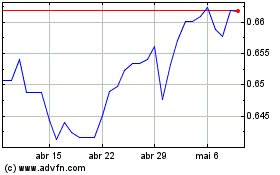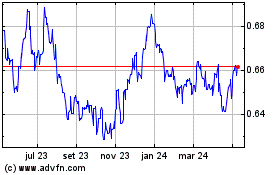Aussie Tumbles To New 2-month Low Against Yen
02 Outubro 2009 - 5:36AM
RTTF2
The Australian dollar extended its previous sessions' losing
streak versus its major opponents on Friday morning in New York as
traders flee from riskier-currencies following the report showed
that the US economy lost more jobs in September than economists had
predicted.
The domestic currency also tumbled after the Australian stock
market suffered its biggest percentage fall in more than 3 months
today. The benchmark S&P/ASX 200 index closed at 4,601, down 99
points or 2.11% and the broader All Ordinaries index fell 96 points
or 2.04% to 4,606.
On the economic front, TD Securities said today that an index
measuring inflation in Australia was up 1.3% on year in September,
marking the slowest rate of increase in seven years. This marked
the fifth straight month that inflation has come in below the
Reserve Bank of Australia's target range of 2%-3%.
The Australian dollar slumped to a 17-day low of 0.8572 against
the US dollar by 8:30 am ET, down around 3.3 percent from
yesterday's fresh 13-month high of 0.8861. The next downside target
for the aussie-buck pair is likely to be seen near the 0.855 level.
At Thursday's close, the pair was worth 0.87.
In the U.S., job losses in September were sharply higher than
economists had expected, driving the unemployment rate to its
highest level in 26 years and pushing the number of people out of
work above 15 million, the U.S. Labor Department revealed
today.
Non-farm payrolls dropped 263,000 in September. Economists had
expected a decline of 170,000 jobs. August's results were revised
to show a decline of 201,000 jobs.
The unemployment rate for September came in at 9.8% compared to
9.7% in the previous month.
The Australian dollar dropped more than 4 percent to 76.35
against the Japanese yen from yesterday's weekly high of 79.58 to
reach its lowest level since July 22nd. The next downside target
for the aussie-yen pair is seen around the 75.7 level.
Japan's jobless rate edged down in August, after hitting a
record high in July, an official report showed today, raising hopes
that sustained recovery in the world's second largest economy may
be well on track. Moreover, consumer spending also increased in
August, after falling in July.
Data released by the Ministry of Internal Affairs and
Communications showed Friday that the jobless rate decreased to
5.5% in August, on a seasonally adjusted basis, from a record high
of 5.7% in July. Moreover, the rate came in below economists'
expectations for 5.8%.
Elsewhere, the Bank of Japan said today the monetary base rose
4.5% year-on-year in September to 92.39 trillion yen, following a
6.1% rise in August. Seasonally adjusted, the monetary base was
down 11.9% in September.
Extending its 2-day losing streak, the Australian currency
declined to a 4-day low of 1.2065 against the New Zealand dollar
around 8:30 am ET. This may be compared to yesterday's close of
1.218. If the aussie drops further, likely support is seen around
the 1.204 level.
The Australian dollar that surged to a 14-month high of 1.6519
against the European currency on Thursday pared more than 2.4
percent to reach a 4-day low of 1.6931 by 8:30 am ET Friday. The
euro-aussie pair, which closed yesterday's deals at 1.6729, is
presently worth 1.6886 with 1.70 seen as the next target level.
The Eurostat said today in a report that Eurozone industrial
producer price index or PPI dropped 7.5% year-on-year in August,
compared with a 8.4% fall in the previous month. The July month
figure was revised from 8.5% decline reported initially. Economists
expected a decline of 7.6%.
Month-on-month, producer prices increased 0.4% in August, after
falling 0.7% in July , revised from 0.8% drop estimated initially.
Economists were looking for a decline of 0.4%.
AUD vs US Dollar (FX:AUDUSD)
Gráfico Histórico de Câmbio
De Jul 2024 até Ago 2024

AUD vs US Dollar (FX:AUDUSD)
Gráfico Histórico de Câmbio
De Ago 2023 até Ago 2024
